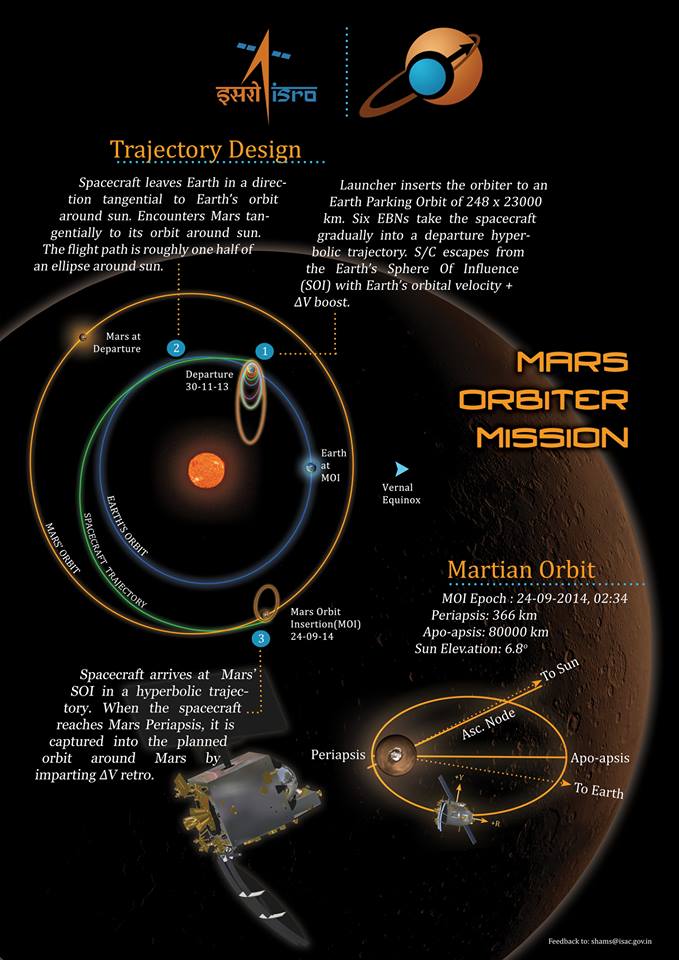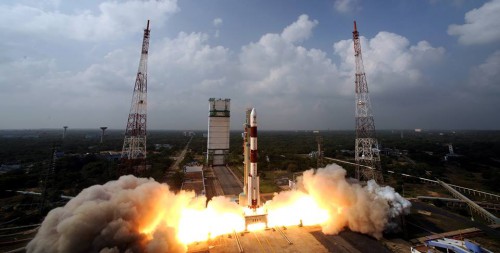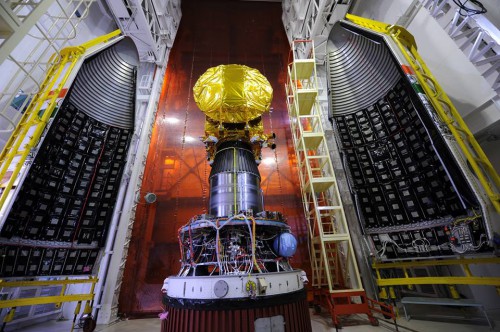
Two days after Sunday’s triumphant arrival of NASA’s Mars Atmosphere and Volatile EvolutioN (MAVEN), India is drawing closer to its goal of becoming only the fourth nation or group of nations—after the United States, Russia and the member states of the European Space Agency (ESA)—to successfully deliver a home-grown spacecraft to Mars orbit. Its Mars Orbiter Mission (MOM), also known as “Mangalyaan” (Hindi for “Mars Craft”), is now less than two days from its scheduled entry into orbit around the Red Planet at 7:30 a.m. IST Wednesday, 24 September (10:00 p.m. EDT Tuesday, 23 September). According to the Indian Space Research Organisation (ISRO), the spacecraft was last week more than 134 million miles (215 million km) from Earth and has traveled in excess of 406 million miles (653 million km) on its “heliocentric” path to reach Mars, but as of 15 September was less than 1.6 million miles (2.5 million km) from its destination. With one-way communication delay times now requiring 12.5 minutes to cross the interplanetary gulf, MOM/Mangalyaan has 98 percent and more than 320 days of its epic journey behind it…and yet its most hazardous phase is still ahead of it.
Launched atop India’s Polar Satellite Launch Vehicle (PSLV) from the Satish Dhawan Space Centre, on the barrier island of Sriharikota, within the southern state of Andhra Pradesh, last 5 November, MOM/Mangalyaan’s ability to reach Mars was restricted by the relatively limited propulsive yield of both the rocket and its own Liquid Apogee Motor (LAM). These factors made it infeasible to inject it directly onto a trans-Mars trajectory, in the same manner as MAVEN. Instead, it was inserted very precisely into a highly elliptical Earth orbit of about 155 x 14,600 miles (250 x 23,500 km) by the PSLV. It was then tasked with executing six LAM “burns”, over a three-week period, to steadily expand its apogee to a maximum distance of 119,846 miles (192,874 km) from Earth, whereupon it would escape the Home Planet’s sphere of influence and establish itself onto a hyperbolic trajectory to rendezvous with Mars about ten months later.
Following its launch, MOM/Mangalyaan was placed into an orbit which very closely paralleled pre-flight predictions, inclined 19.27 degrees to the equator and with a period of a little less than seven hours. After separation from the final stage of the PSLV, its main antenna and electricity-generating solar arrays were deployed and the first orbit-raising burn of the LAM took place on 7 November. It lasted 416 seconds and lifted MOM/Mangalyaan’s apogee to 17,550 miles (28,852 km). Subsequent burns further expanded this apogee, firstly to 24,970 miles (40,186 km) on 8 November, then to 44,500 miles (71,636 km) on 9 November and later—after minor technical difficulties—to 73,720 miles (118,642 km) by 12 November. The next LAM firing on 16 November pushed the spacecraft yet further to 119,846 miles (192,874 km) and the final boost on 1 December enabled it to leave Earth’s gravitational influence and set sail for Mars.

Tracked by the Spacecraft Control Centre at ISRO Telemetry, Tracking and Command Network (ISTRAC) in Peenya, Bangalore, and supported by the Indian Deep Space Network (IDSN) at Byalalu, MOM/Mangalyaan utilized its 22-Newton thrusters to execute the first of four planned Trajectory Correction Maneuvers (TCM-1) on 11 December, by which time the spacecraft was 1.8 million miles (2.9 million km) from Earth and by April 2014 it had crossed the halfway mark in its journey. The follow-up TCM-2 maneuver was originally planned for 9 April, in order to make minor trajectory adjustments in response to solar radiation pressure, but MOM/Mangalyaan was adhering so closely to its pre-planned flight profile that the burn proved unnecessary and was postponed until 11 June. At this point, it had attained a distance of 63.4 million miles (102 million km) from Earth and had traveled 290 million miles (466 million km) of its heliocentric journey.
A third burn was originally planned for August, but also proved unnecessary. “MOM is closely following its trajectory and the mission managers have just ruled out the need for a Trajectory Correction Maneuver, originally planned for August 2014, which means MOM needs only three of the four TCMs originally planned for the heliocentric journey,” explained ISRO on its Facebook page. “All the parameters of the spacecraft are within limits. We will review again in the end of August whether any trajectory correction is needed before its injection in Mars orbit next month.” Last Tuesday (16 September), time-tagged commands to perform the critical Mars Orbit Insertion (MOI) maneuver were uploaded to the spacecraft, followed by a series of instructions for the upcoming TCM-4 burn.
The TCM-4 burn occurred perfectly at 2:30 p.m. IST (5:00 a.m. EDT) Monday, 22 September. It lasted 3.968 seconds and expended about 1.1 pounds (0.5 kg) of propellant. With typical understatement, ISRO noted that “Test Firing of Main Liquid Engine of Mars Orbiter Spacecraft is Successful” on its website. Unlike the TCM-1 and TCM-2 burns, which utilized the spacecraft’s eight 22-Newton attitude-control thrusters, the TCM-4 firing marked the first test of the 440-Newton LAM engine, which had not been fired since the inaugural Earth-departure maneuvers, about 300 days earlier in late 2013.

With the success of TCM-4, early Wednesday the LAM and the eight attitude-control thrusters will be fired in tandem for the MOI maneuver. “We are confident the engine will work,” explained Koteshwar Rao, ISRO’s scientific secretary, “but just in case it doesn’t, we have a Plan B that involves firing the eight thrusters for a longer time.” However, Mr. Rao cautioned that employing the 22-Newton thrusters alone would consume a larger quantity of propellant in order to achieve a stable orbit around Mars.
As Wednesday dawns over India, it will be the moment of truth for a nation of 1.2 billion people, as their first spacecraft begins the final stages of its mission to reach Mars. Unsurprisingly, MOM/Mangalyaan has generated pride and criticism in equal measure. It has been described as “a technology demonstration project” and its primary goal is to prove that India can design, build, manage, launch and operate a deep-space voyage across an immense interplanetary gulf. It only received received formal approval and a $41 million injection from the Indian Government in August 2012 and its opponents have argued that the money could be better spent on issues such as power failures and droughts. Others have countered that “India is today too big to be just living on the fringes of high technology”.
About three hours before the start of MOI on Wednesday, the spacecraft will transfer communications over to its Medium Gain Antenna. At 7:14:32 a.m. IST Wednesday (9:44:32 p.m. EDT Tuesday), with three minutes remaining before LAM ignition, the eight 22-Newton thrusters will be brought online to support attitude controllability. This will serve to establish the proper conditions for the LAM, which will fire at 7:17:32 a.m. IST Wednesday (9:47:32 p.m. EDT Tuesday). Due to the lengthy round-trip communications time with Earth, ISRO controllers expect to receive confirmation of the LAM ignition about 12.5 minutes later, at 7:30:02 a.m. IST Wednesday (10:00:02 p.m. EDT Tuesday).
The LAM will burn for 24 minutes and 14 seconds, shutting down at 7:41:46 a.m. IST Wednesday (10:11:46 p.m. EDT Tuesday). It will consume about 550 pounds (249.5 kg) of propellant, impart a delta-V of 3,604.6 feet per second (1,098.7 meters per second) and establish MOM/Mangalyaan into a highly elliptical orbit of 263 x 50,000 miles (423 km x 80,000 km), with a period of 3.2 days.
The 2,980-pound (1,350 kg) spacecraft is equipped with five discrete scientific instruments—the Methane Sensor for Mars (MSM), Mars Colour Camera (MCC), Mars Exospheric Neutral Composition Analyser (MENCA), Thermal Infrared Spectrometer (TIR), and Lyman-Alpha Photometer (LAP)—and will demonstrate the technology needed to deliver a spacecraft to the Red Planet and conduct meaningful science. Upon arrival, MOM/Mangalyaan will spend at least six months orbiting Mars, focusing on the morphology, topography and mineralogy of the surface, together with the dynamics of its thin upper atmosphere, its loss of water, the influence of solar wind and radiation, and the nature of its moons, Phobos and Deimos. Hopes are high for the mission, as India sets out on a path to become the fourth discrete organization, nation or group of nations to successfully send its own mission to Mars. Only Russia, the United States, and the member states of the European Space Agency (ESA) have accomplished this feat to date.
Want to keep up-to-date with all things space? Be sure to “Like” AmericaSpace on Facebook and follow us on Twitter: @AmericaSpace
Missions » MOM »




Fingers crossed that MOM has better luck than Japan’s Nozomi or China’s Yinghuo 1 and successfully makes it into orbit around Mars. More than one Mars mission has failed orbit insertion but it seems that ISRO has learned from these earlier failures.
http://www.drewexmachina.com/2014/06/23/planetary-orbit-insertion-failures-part-ii/
I have been following your articles on the Mangalyaan, and you have consistently provided the best coverage along the timeline of this programme, since its inception to this day. Kudos to the writers who have well presented an overall coverage of the technical, economical and emotional aspects of this mission, as well as presenting criticisms and justifications for the same.
All the best, ISRO, may this mission be a shining planet on your successful missions track record. Again, thanks to the writers who are providing a satisfactory read consistently. Keep up the good work, you are being appreciated :).
India reached Mars @ cost of IndianRupees 6 per kolometer.
Is’nt it cheap foray.
Come on u can’t even get a cab as this
cheap rates….lolz
Congratulation ISRO. proud of you